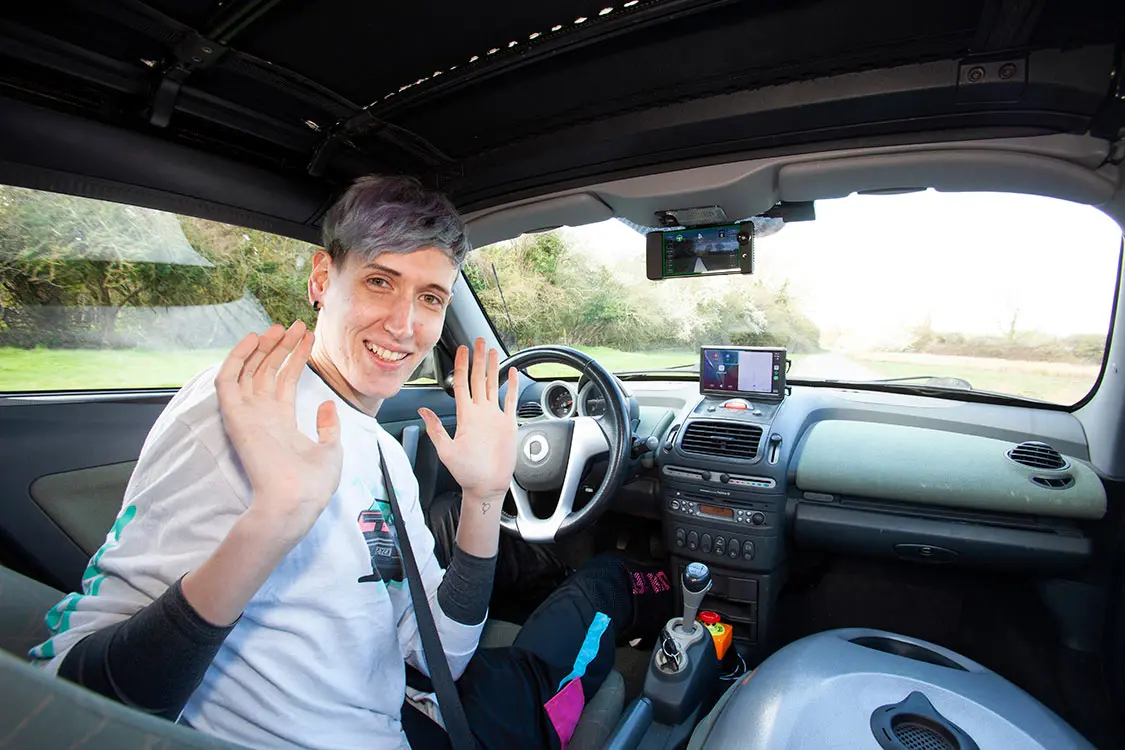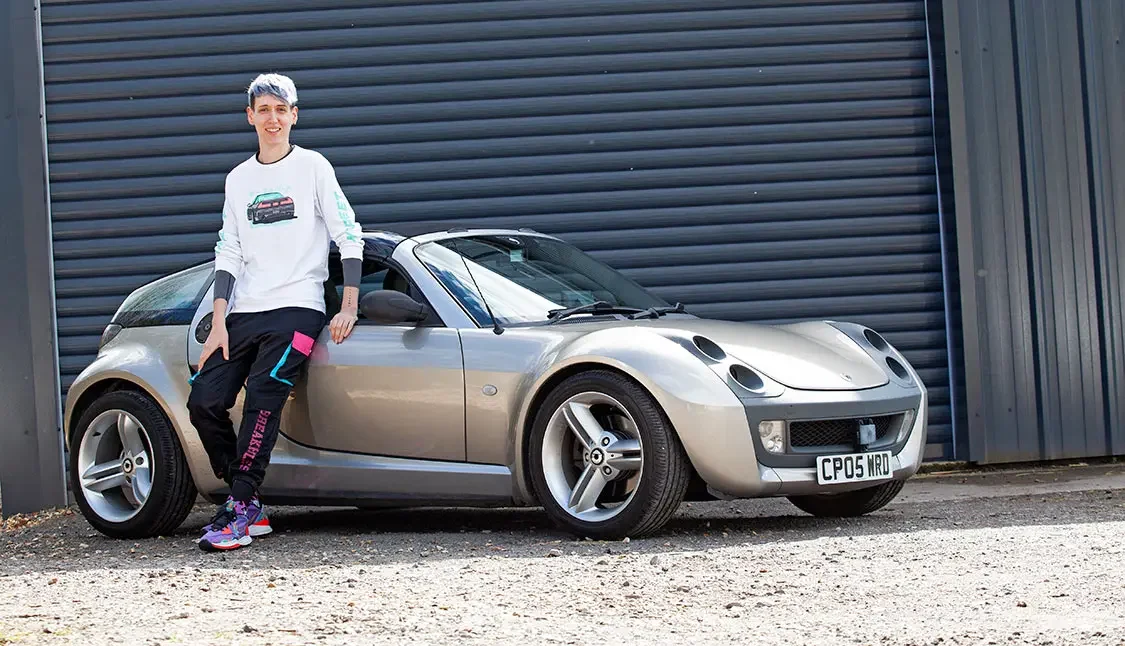 Jerome Andre
.
August 28, 2023
.
Electric Vehicle Features
Jerome Andre
.
August 28, 2023
.
Electric Vehicle Features

In an EV world captivated by self-driving technology, one innovator, Seb Smith, took matters into their own hands and transformed a humble Smart car into a semi-autonomous marvel.
With experience gained at Rivian in the US, Zero EV in the UK, and relentless determination, Seb, based in London, meticulously engineered a complete retrofit system to convert any car to autonomous driving. In principle, this can be installed on any classic and modern classic reasonably straightforwardly. That said, it is currently being utilized on several early Tesla Model Ss that lack self-driving capabilities from the factory.
It is important to note that this project is still in its developmental stage and is solely intended for DIY enthusiasts looking to develop their engineering and coding skills. However, if you’re interested in upgrading your vehicle to Level 2 Autonomy, Seb, a prototype build engineer at Rivian and Software & Electronics department manager at Zero EV (Fellten), is the expert to consult. We had the opportunity to interview Seb and gather their insights on this solution and the overall process.
My family lives in Scotland, eight hours from me, and I drive up there often. I noticed 90% of the driving is dull and boring driving on motorways that a computer could efficiently perform. So, I looked at what systems were available. I concluded I would either have to get the highest-spec BMW, Mercedes Benz with lane keeping and adaptive cruise control, or buy a Tesla with Autopilot or Full Self Driving. From then on, my new goal was to get autonomous driving without purchasing a brand-new EV. There are five levels of autonomous driving. My Smart car is a Level 2 system that allows autonomous control in certain situations but relies on a human fallback at any time. When the system is operating, it uses the smartphone’s front-facing camera to monitor the driver’s face and ensure they are attentive. This means you don’t have to keep nudging the wheel like in most other EVs, which makes the experience far more relaxing.
The system’s main components include a smartphone with supporting software called Openpilot, developed by Comma.ai. In addition, various parts were selected from different vehicles, such as the braking setup from Tesla, elements from Volkswagen and Honda, and the steering angle sensor from Toyota. These components were chosen based on their compatibility and successful utilization in Openpilot by other users. Custom ECUs and gateways I designed from scratch are also integral to the system.
Another implementation was fitting the Tesla iBooster. Since it was designed by Bosch, an OEM for Mercedes, and the Smart was designed by Mercedes, the Tesla iBooster bolted straight into the Smart—the firewall bolt pattern and brake pedal interface were a direct fit! It just required the frunk liner to be trimmed out and a smaller brake fluid reservoir fitted. I also swapped out the master cylinder for one from a VW e-Golf to match the Smart’s smaller brake calipers compared to the 4-piston ones in the Tesla.

Last, I had to work on the Smart Car’s CANbus. The car was released in 1999 and was one of the first few vehicles to have a CAN bus. Therefore, it was much more straightforward than modern cars. For comparison, the amount of traffic is about 50 times lower than found in new Teslas. However, I was quickly able to extract some critical data such as the four-wheel speeds, engine rpm, throttle value, turn signal status, doors, and lights. This made it much easier to integrate into Openpilot. If the car didn’t have a CANbus, it would have been far harder to interface these items into the Openpilot self-driving agent.
This system offers several advantages over regular autopilot systems. One notable drawback of OEM autopilots is the requirement to keep hands on the wheel and consistently nudge it. Openpilot, on the other hand, through continuous driver monitoring, ensures that the driver remains attentive while allowing them to sit back and let the car handle tasks such as lane changes. While it is still necessary to pay attention to the road, this makes long drives significantly more relaxing.

Finding a way to actuate brakes autonomously was the hardest piece of the puzzle. The car has ABS, but it was never designed to actuate the brakes very fast, slow down the car extremely quickly, or hold on to the brakes for extended amounts of time without the ABS motor getting hot. So, I went to Tesla for inspiration and discovered they use an electromechanical brake servo called the iBooster. This has many advantages, as it has a very powerful brushless motor that provides vacuum-independent brake assistance (critical in EVs). It can also be commanded to brake autonomously and slow the car at very fast speeds. I decided to reverse-engineer it so I could use it in my build. I could not start the Smart build until I had a braking solution, so I spent several months reverse engineering, taking logs from working Tesla and decoding the CAN signals. Finally, I had autonomous control of the iBooster and developed a controller ECU, which I offer as an entire kit to allow anybody to retrofit an autonomous ready braking system to their car.
Yes, during the process, I discovered a few shortcuts. Prior to connecting and implementing the Openpilot system, I utilized a radio control remote to test the functionality of the actuators, including steering, gas, and brakes. This allowed me to remotely control the brakes, which proved particularly beneficial during the bleeding process. It meant I could do it on my own by using one hand to operate the remote control and the other to close the brake caliper’s bleed nipple.
Once the steering and gas systems were operational, I essentially had a full-size remote-controlled car. I could drive myself around the parking lot while sitting in the passenger seat or operate the vehicle with nobody inside. Interestingly, this aspect of the project garnered unexpected interest from the film industry. I envisioned other practical applications, such as remotely maneuvering off-road vehicles over rough terrain without requiring a spotter or effortlessly parking a car in a very tight space by controlling it from outside the vehicle.
When embarking on any EV conversion project, it is crucial to carefully consider the integration of steering and braking components that are compatible with self-driving technology from the initial stages. Even if the self-driving functionality is not immediately utilized, incorporating these components allows for the option to retrofit the technology at a later time. For individuals contemplating the addition of such technology to their conversion project, I encourage reaching out to me as I can provide guidance and support throughout the build process. My website is located at: sghinnovations.com
After using the semi-autonomous driving system for approximately three years, I have accumulated over 23,000 miles of autonomous driving based on my logs. About 75% of my regular commute is now handled autonomously. This highlights the ability of a relatively simple and basic system to reduce driver fatigue and enhance vehicle safety. The system has proven itself by detecting and reacting to hazards I may have missed, taking control, and applying the brakes when necessary.
Building a car from the ground up gave me full control over the actuators. While I have added safety limits, they are higher than current production vehicles. Therefore, it will enable the Smart to tackle tighter bends and faster emergency stops than most cars.
SEB SMITH
FSD SYSTEM
CHASSIS/SUSPENSION
INTERIOR
We use cookies to enhance your browsing experience, serve personalized ads or content, and analyze our traffic. By clicking "Accept All", you consent to our use of cookies. Visit our Cookie Policy for more info.
Notifications
Share Link